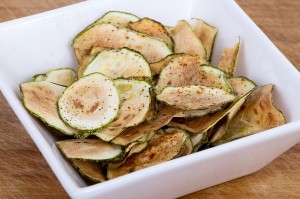You are what you eat. Or more accurately, you are what you feed the trillions of little critters that live in your gut.
The lining of your gut, like every surface of your body, is covered in microscopic creatures, mostly bacteria. These organisms create a micro-ecosystem called the microbiome. Though we don’t really notice it’s there, it plays an oversized role in your health and can even affect your mood and behavior.
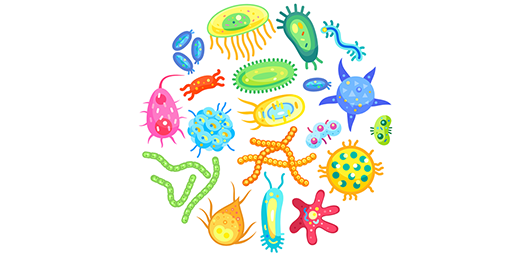
Not surprisingly, what you feed your microbiome may have the biggest impact on its health. And the healthier it is, the healthier you are.
The gut bacteria, collectively referred to as the gut flora or gut microbiome, perform many important functions in the body.
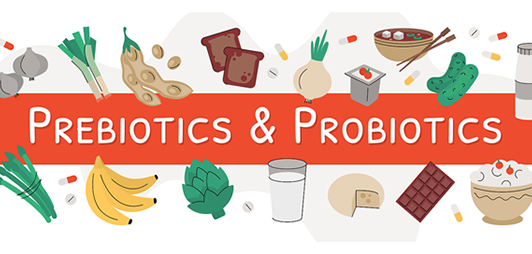
There are two ways to maintain this balance, helping the microbes already there to grow by giving them the foods they like (prebiotic) and adding living microbes directly to your system (probiotic).
Eating balanced amounts of both pro- and prebiotics can help ensure that you have the right balance of these bacteria, which should improve your health. Probiotics are live bacteria and yeasts that, when administered in a viable form and in adequate amounts, are beneficial to human health. They are usually added to yogurts or taken as food supplements. Prebiotics are substrates that are selectively used by the host microorganisms, which confer health benefits.
We are entering an era where we can increasingly modify health through food and measure the effects through our microbes or metabolites. Fibre is a key nutrient for a healthy microbiome and has been overlooked while debates have raged about sugar and fat. The adverse effects on the microbiome of drugs and processed food ingredients can no longer be ignored.
Prebiotics
When our gut bacteria get the proper foods, they can ferment them into short-chain fatty acids, compounds which nourish the gut barrier as well as help prevent inflammation and mend insulin sensitivity—all three things essential for weight loss. They also have the proper fuel to perform other regulatory functions, like keeping your appetite in check and your skin glowing. Unlike probiotics that are commonly found in pill form, prebiotics are generally consumed in the diet or as a powder that can be added to foods like smoothies and oatmeal.
Ready to get started? Below we’ve collected a list of the best prebiotic fuels that boost the effectiveness of your gut and set you well on your way to a slimmer, happier you.
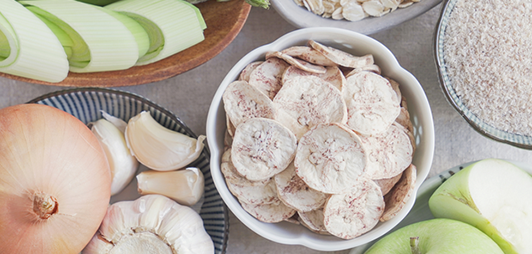
The best prebiotic foods for gut health:
- Chocolate: a study published in the American Journal of Clinical Nutrition found that those who consumed drinks with a higher percent cocoa solids saw an increase in the beneficial microbes Bifidobacteria and Lactobacilli as well as a decrease in undesirable gut microbes called Clostridia. You can even enhance the effects by pairing chocolate with some apple slices. The fruit speeds up the fermentation process, leading to an even greater reduction in inflammation and weight. To reap the most benefits, pick a chocolate with the highest percentage of cocoa.
- Underripe Banana: an excellent source of nondigestible carbohydrates that act as food for good gut bacteria. So excellent, in fact, that they have not one, but two sources! One is fructooligosaccharides (FOS), a cluster of fructose molecules that feeds your beneficial Bifidobacteria bacteria, a species which is typically in low concentrations in obese people. And when they’re green, bananas also act as a source of resistant starch—yet another form of prebiotic.
- Pulses: pulses, like lentils, split peas, beans, and chickpeas are a source of “resistant starch.” They pass through the small intestine intact, meaning these leftovers can move into the large intestine as food for your gut bacteria. The microbes ferment them into a fatty acid called butyrate, which helps to turn off the genes that lead to inflammation and insulin resistance. A recent study in the Journal of Functional Foods found that when you eat resistant starch, your gut biome gets stronger.
- Onion: Onions are one of the best sources of the gut-healthy, soluble fiber called oligofructose, a natural source of inulin which the gut uses to clean itself, as well as increase the numbers of good bacteria.
- Garlic: Just like onions, garlic contains high levels of a type of fiber called inulin, which feeds bacteria from the phylum Actinobacteria. Not to mention, garlic also has antimicrobial properties, which can also be a good thing for our microbiomes as it helps kick the bad guys out.
- Leeks: leeks will help you flavor your dishes with their mildly sweet flavor. This prebiotic powerhouse is rich in the same fiber as onions, inulin. In addition to promoting a healthy gut flora, inulin can stimulate your bone health by enhancing calcium absorption.
- Spinach: leafy greens contain a unique long-chain sugar molecule known as Sulfoquinovose (SQ). Because of its length, SQ isn’t digested in the small intestine and moves down to the lower intestine to feed your good bacteria, which is a “protective” strain of E. coli, promoting their growth in the gut. When this strain of E. coli is strong, it can provide a protective barrier in the gut, preventing the growth and colonization by bad bacteria.
- Oats: Oats are a great source of an indigestible form of soluble fiber called Beta-glucans. These fibers not only feed your gut bacteria but have also been connected with improved insulin sensitivity as well as lower levels of “bad” LDL cholesterol
- Jerusalem Artichoke: This type of artichoke is about 76% inulin, making them one of the foods highest in this prebiotic fiber.
- Blueberries: This antioxidant-rich, anti-aging berry, contains prebiotic fiber. According to a study, daily blueberry consumption in mice showed an improvement in the balance of the gut microbiota in favor of members of the “good guy” bacteria group,Actinobacteria and lower in the “bad guy” Enterococcus, bacteria, which can be responsible for infections.
- Apples: Pectin is a natural fruit fiber found in apple peels that a study published in the journal Anaerobe found was powerful enough to support the growth of the beneficial bacteria Bifidobacteria and Lactobacillus. Apples also help build better gut health with their sources of inulin and fructooligosaccharides (FOS). they’re also packed with antioxidants and have been found to lower cholesterol, as well as protect you from metabolic syndrome, coronary heart disease, and cardiovascular disease.
- Dandelion greens: One of the best prebiotic sources for your gut is growing in your grass. These bitter-sweet spring greens are bursting with fiber, antioxidants, vitamins, and minerals. They are also a diuretic, which means they can help blast excess weight by helping your body get rid of extra fluids. And studies have found that this plant is protective against obesity, as well as depression, and fatigue. In fact, you’d only need 1 oz of these greens to provide you with an entire daily serving of fiber. Use them in a salad or steep them in a tea.
- Chia and Flax seeds:These seeds are some of the best plant sources of anti-inflammatory omega-3s known as alpha-linoleic acid (ALA), which your body converts to the same helpful omega-3s found in fatty fish. If you’ve ever made chia pudding, you’ve seen the gel-forming effect of the seeds’ prebiotic soluble fibers, which do the same thing in your gut, helping to repair the gut lining as well as feed your microbes. Grind flax seed fresh or keep frozen to maintain their quality, and add it along with chia seeds to your yogurt, smoothies, or cereals.
Probiotics
Probiotics are live bacteria that are good for your digestive system and may help you extract nutrients from your food. They are naturally found in some dairy products, like live-culture yogurts and some cheeses—and fermented foods, like kimchi, miso, sauerkraut, and kombucha. You may have heard of probiotic supplements- those large pills that say “millions” or “billions” of live bacteria on the bottle. Although there is a place for supplementation with pills, we can make a big change by just including some of these foods into our diet regularly.
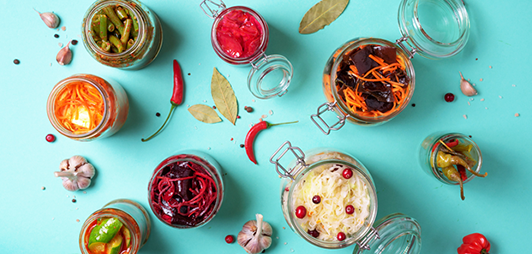
Here is a list of probiotic foods that are super healthy:
- Yogurt : yogurt is one of the best sources of probiotics. It is made from milk that has been fermented by friendly bacteria, mainly lactic acid bacteria and bifidobacteria. Eating yogurt is associated with many health benefits, including improved bone health. It is also beneficial for people with high blood pressure, and may help reduce the diarrhea caused by antibiotics. It can even help relieve the symptoms of irritable bowel syndrome (IBS). Additionally, yogurt may be suitable for people with lactose intolerance because the bacteria turn some of the lactose into lactic acid, which is also why yogurt tastes sour.
However, keep in mind that not all yogurt contains live probiotics. In some cases, the live bacteria have been killed during processing. - Kefir: Kefir is a fermented probiotic milk drink. It is made by adding kefir grains to cow’s or goat’s milk. Kefir grains are cultures of lactic acid bacteria and yeast that look a bit like cauliflower. Kefir has been linked to various health benefits. It may improve bone health, help with some digestive problems and protect against infections.While yogurt is probably the best known probiotic food in the Western diet, kefir is actually a better source. Kefir contains several major strains of friendly bacteria and yeast, making it a diverse and potent probiotic.
- Sauerkraut: Sauerkraut is finely shredded cabbage that has been fermented by lactic acid bacteria. It is one of the oldest traditional foods and is popular in many countries, especially in Europe. In addition to its probiotic qualities, sauerkraut is rich in fiber as well as vitamins C, B and K. It is also high in sodium and contains iron and manganese. Sauerkraut also contains the antioxidants lutein and zeaxanthin, which are important for eye health. Make sure to choose unpasteurized sauerkraut, as pasteurization kills the live and active bacteria.
- Kimchi: Kimchi is a fermented, spicy Korean side dish. Cabbage is usually the main ingredient, but it can also be made from other vegetables. Kimchi is flavored with a mix of seasonings, such as red chili pepper flakes, garlic, ginger, scallion and salt. Kimchi contains the lactic acid bacteria Lactobacillus kimchii, as well as other lactic acid bacteria that may benefit digestive health. Kimchi made from cabbage is high in some vitamins and minerals, including vitamin K, riboflavin (vitamin B2) and iron.
- Pickles: cucumbers that have been pickled in a solution of salt and water. They are left to ferment for some time, using their own naturally present lactic acid bacteria. This process makes them sour. Pickled cucumbers are a great source of healthy probiotic bacteria which may improve digestive health. They are low in calories and a good source of vitamin K, an essential nutrient for blood clotting. Keep in mind that pickles also tend to be high in sodium. It is important to note that pickles made with vinegar do not contain live probiotics.

